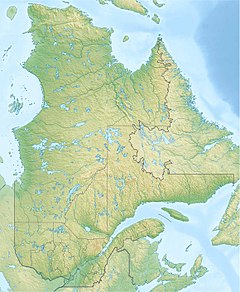geo.wikisort.org - River
The Laberge River is a tributary of Lake Hebert, flowing in Canada, in:
- Rattray Township of Timiskaming District, in Northeastern Ontario;
- Rollet and Montbeillard sectors in the Northwest of Regional County Municipality (RCM) of Rouyn-Noranda, Abitibi-Témiscamingue, in Quebec.
| Laberge | |
|---|---|
| Location | |
| Country | Canada |
| Provinces | Quebec, Ontario |
| District | Abitibi-Témiscamingue, Timiskaming |
| Municipality | Rouyn-Noranda |
| Physical characteristics | |
| Source | Icefish Lake |
| • location | Timiskaming District, Ontario |
| • coordinates | 47°58′19″N 79°31′57″W |
| • elevation | 290 m (950 ft) |
| Mouth | Lac Buies |
• location | Rouyn-Noranda, Abitibi-Témiscamingue, Quebec |
• coordinates | 48°00′34″N 79°30′07″W |
• elevation | 264 m (866 ft) |
| Length | 10.6 km (6.6 mi) |
| Basin features | |
| River system | Saint Lawrence River drainage basin |
Forestry is the main economic activity of this hydrographic slope; recreational and tourism activities, in second.
Annually, the surface of the river is generally frozen from mid-November to late April, however, the period of safe ice circulation is usually from mid-December to early April.
Courses
The river begins at the mouth of Icefield Lake (length: 1.4 kilometres (0.87 mi) altitude: 290 metres (950 ft)) in Rattray Township, District of Timiskaming, in Ontario. This lake is located at 1.3 kilometres (0.81 mi) Southeast of a mountain with a peak of 429 metres (1,407 ft), and at 0.5 kilometres (0.31 mi) at West of the border Ontario - Quebec.
From the mouth of Icefield Lake, the Laberge River flows over 10.6 kilometres (6.6 mi), according to the following segments:
- 3.5 kilometres (2.2 mi) south, then east, in Rattray Township, Timiskaming District, Ontario, to the border of Quebec;
- 0.5 kilometres (0.31 mi) in the Rollet sector, the Regional County Municipality (MRC) of Rouyn-Noranda, Abitibi-Témiscamingue, Quebec;
- 2.6 kilometres (1.6 mi) to the North, crossing Lake Laberge (length: 2.6 kilometres (1.6 mi); width: 1.9 kilometres (1.2 mi); altitude: 275 metres (902 ft));
- 2.1 kilometres (1.3 mi) North to the southern boundary of the Montbillard area of the regional county municipality (RCM) of Rouyn-Noranda;
- 1.9 kilometres (1.2 mi) North in the Montbeillard sector to its mouth.[1]
The mouth of the Laberge River empties onto the South shore of Lake Hébert. This confluence is located at:
- 1.2 metres (3 ft 11 in) Southwest of the Quebec - Ontario border;
- 5.7 kilometres (3.5 mi) South of the mouth of the Lac Hébert outlet (confluence with Lake Buies);
- 6.2 kilometres (3.9 mi) Northeast of the mouth of Raven Lake (Ontario);
- 30.8 kilometres (19.1 mi) Northwest of the mouth Larder River (Ontario).
Toponymy
The term "Laberge" is a family name of French origin.
The toponym "Laberge River" was formalized on December 5, 1968, by the Commission de toponymie du Québec, when the commission was created.[2]
Notes and references
- River segments measured from the Atlas of Canada (published on the Internet) of the Ministry of Natural Resources of Canada.
- "Commission de toponymie du Québec - Bank of Place Names - Toponym: "Laberge River"". toponymie.gouv.qc.ca. Retrieved 2017-11-03.
See also
- Lac Hebert, a body of water
- Lake Raven, a body of water
- Laberge River Provincial Park
- Larder River (Ontario), a watercourse
- Blanche River (Lake Timiskaming), a training course
- Lake Timiskaming, a water body
- Ottawa River, a watercourse
- List of rivers of Quebec
Другой контент может иметь иную лицензию. Перед использованием материалов сайта WikiSort.org внимательно изучите правила лицензирования конкретных элементов наполнения сайта.
WikiSort.org - проект по пересортировке и дополнению контента Википедии
